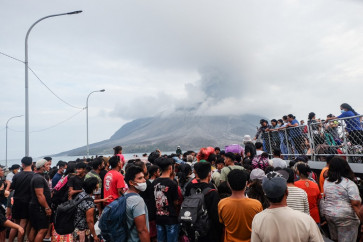Analysis: The impact of the coronavirus outbreak on RI’s CPO sector
The outbreak of the coronavirus which started in Wuhan, China, in December 2019, continues to stoke global fear
Change Size

T
span>The outbreak of the coronavirus which started in Wuhan, China, in December 2019, continues to stoke global fear. The outbreak of the virus, which causes Coronavirus Disease 2019 (COVID-19), is suspected to have first appeared in a wet market in Wuhan city.
The virus spread so fast that the number of infections, which reached 9,700 at the end of January, jumped to more than 83,700 worldwide at the end of February. The death toll increased from 213 at the end of January to 2,800 by the end of February. This is one of the fastest known virus outbreaks in human history.
Most of the infected cases originated at ground zero, Wuhan. The growth rate of infected cases in China seemed to dip in the last week of February. However, the growth rate of the infected cases outside China rose significantly in the same period. The World Health Organization recorded at least 62 countries that have been affected by the outbreak.
So, what is the impact of the COVID-19 outbreak on the economy?
The most direct impact will likely be lower domestic consumption, especially in China, due to city lockdowns during the outbreak period. Chinese manufacturing is also slowing down. The virus has disrupted global supply chains, causing a decline in China’s imports and exports of raw materials. This hurts Indonesia.
The other direct impact is declining foreign tourist arrivals in Indonesia, especially in the main tourist destinations such as Bali. Fewer tourists have translated to fewer hotel rooms booked and less food and beverages consumed. Eventually, the crude palm oil (CPO) demand from tourist destinations will also decline as the second-round impact of the outbreak. But the hardest impact was due to the decline in demand from global buyers especially from China which has caused the slump global prices.
The CPO price in Malaysia’s market dropped to US$559 per ton on Feb. 28, a 26.9 percent drop from the level recorded in early January. On average, CPO prices in February were only $642 per ton, lower than the average price in January of around $727 per ton.
Please note that Mandiri views the CPO price of $727 per ton as too high and not reflective of its fundamental value. CPO substitutions, such as soybean oil, were also impacted by the outbreak. The soybean oil reference price dropped to $28.5 per lbs on Feb. 28, an 18.5 percent decline from the level it was in early January 2020.
The drop in the prices of CPO and soybean oil was caused by declining demand from China and potentially decreasing demand from other infected countries. China is the biggest CPO importer and also the biggest soybean and soybean oil consumer in the world. Therefore, any negative sentiment from China will likely make prices more unstable. During mid-January, most of the Chinese activities in the Hubei region were stopped. The people in the region were advised to stay in their home to minimize contact with other people. Lower activities mean lower overall consumption. Unfortunately, this period should have been the highest season for Chinese consumption due to the Lunar New Year celebrations. This was the starting point of the declining CPO price in 2020. Hence the question we should ask is how deep will the CPO price fall? The answer will depend on how long the COVID-19 peak outbreak lasts, hopefully not for long.
Historically in times of a virus outbreak, the CPO price tends to weaken. For example, Citi Research Group pointed out that the Severe Acute Respiratory Syndrome (SARS) peak outbreak period was in January to March 2003 (approximately three months), while the Avian Influenza outbreak took place in January to August 2004 (approximately eight months) and the Middle Eastern Respiratory Syndrome (MERS) outbreak occurred in September to November 2012 (approximately three months). During these periods, the CPO price declined approximately 12.4 percent (SARS), 12.6 percent (Avian Influenza) and 25.8 percent (MERS). After the outbreak, the CPO price recovered to its original levels for the rest of the year.
Similar to COVID-19, SARS and Avian Influenza’s ground zero was also China, while MERS burst out in the Middle East. MERS also occurred during a global commodities rout, thus the negative impact on the CPO price might not have been caused solely by the outbreak. Based on this, we see SARS and Avian Influenza as appropriate flu virus benchmarks to determine the negative impact of COVID-19. The price drop due to SARS could be the proxy for the three-month outbreak, while Avian Influenza for the six-month outbreak. However, to get a more accurate projection, the discount should be applied to the CPO fundamental price.
As per our last analysis, the fundamental average CPO price for 2020 is $613 to 650 per ton. Using this figure, if the COVID-19 outbreak lasts for three months, our calculation shows that the average CPO price for 2020 is $590 to $600 per ton. If the COVID-19 outbreak lasts for six months, our calculation shows that the average CPO price for 2020 is at $567 per ton. The worst-case scenario is if the outbreak in China lasts for 12 months or China lock all its international interactions, then the average CPO price might fall to $440 per ton or lower this year. The condition could be worse if India and the European Union are also affected by the outbreak like China. These three regions are the biggest CPO consumers in the world, thus demand will dip significantly.
Theoretically, increasing domestic CPO demand through the biodiesel program can minimize the impact of declining demand from China. However, this is not an immediate solution because Indonesia needs to increase its biodiesel capacity first. The more short term solution is searching for new markets, such as in the Middle East or Africa. But this would not be easy due to fierce competition with other vegetable oils, especially the ones that are losing their demand from China. Overall, the uncertainty in the CPO sector remains high in 2020 and all CPO players should prepare for any scenario. If the outbreak lasts for one year, the CPO price might face its lowest level in decades.
______
The writer is an industry analyst at Bank Mandiri









